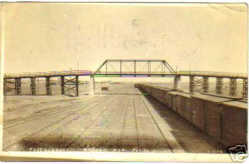- Pete Matz: railroad engineer and singing sensation (3/28/25)
- Historic shift: Women hired at McCook Roundhouse (3/21/25)
- Who were they? Seeking names for these historic snapshots (3/14/25)
- McCook’s government transformed in 1950; city manager form of government adopted and first female councilperson elected (3/7/25)
- Beyond the front lines: Veterans who shaped our communities (2/28/25)
- Civil War stories: The bugler and the drummer (2/21/25)
- Jack Benton: A broadcast trailblazer (2/7/25)
Construction of viaduct at railyard moves full steam ahead in 1909
Friday, January 3, 2020

How often do you use a facility, travel a road or enter a building and really appreciate the fact that someone in the past looked to the future and created a perfect solution to a need that still exists today? Have you ever given thought to the fact that the City of McCook has zero at grade railroad crossings? Can you name even one town in Nebraska that has that claim to fame? Probably not because I don’t believe that any other exists.
At grade crossings within city limits are the bane of every town that has one. They are dangerous, irritating, rough to traverse and the whistles and bells scream railroad through the night much to the dismay of the anyone close to the action.
McCook did have at grade crossings in the late 1800s when the city was developed north of the rail tracks. Two of those crossings were located at each end of the switch yard, East 6th street and West 6th street more commonly known today as Federal Ave. Accidents at those crossings mostly consisted of run-away horse and buggy accidents, some of which ended in fatalities. In addition, the foot traffic across the rail yard by not only workers but also children and other residents of south McCook was concerning to everyone involved.
The first mention of a viaduct being built was deemed to solve the foot traffic problem. While most of us referred to the old structure over tracks as the walkway, in the McCook Tribune, February 16, 1906, it was announced that: “Order has been received at McCook headquarters to build a viaduct over the tracks between the depot and the round house and machine shop, and the work will begin shortly on this needed improvement. It is to be regretted, however, that the order does not carry with it power to construct an underground way between the points above mentioned, which would certainly be more useful to the company in the long run, especially in view of the fact that the company contemplates in the future to pipe steam from the roundhouse to heat the headquarters building, eating house and freight house, etc.”
The first indication of viaduct locations for automobile or wagon traffic came in June of 1906 when the railroad Superintendent Eaton met with the McCook Commercial Club stating that: “A viaduct will be built over the tracks at the foot of McDowell street (today’s West 3rd) and a foot viaduct over the tracks at the foot of Main Avenue (today’s Norris Avenue).” McCook Tribune June 29, 1906. The caveat to this was that the railroad wanted to close the crossing south of Manhattan street and would not excavate a subway at that location. The Tribune’s editor was outspoken in keeping that crossing open with either a subway or a viaduct and against having a crossing at the ice house, the proposed West 3rd location plus he said they must provide a viaduct at the East end of town also.
By November 1906, an underground crossing south of Minnesota street, and about south of the West school building was being considered. The viaduct offers from the railroad included the city being responsible for the maintenance of the viaduct which would be 1,400 feet long and 20 feet wide. Built at a cost of around $25,000.00, annual caretaking was estimated to be $1,000 a year, more than the city could afford to commit to.
Negotiations between the entities continued for two more years but by 1909 the final plans were approved, and the railroad had budgeted for the construction of a viaduct over the rail yards at the East 6th street location.
Designed to span 15 tracks, ten more than existed, the East 6th viaduct construction began in the summer of 1909. Ordinance No. 137, relating to the erection and maintenance of a viaduct and the construction and maintenance of an underground passage and the closing of certain streets within the city, had passed its third reading in October of 1907 clearing the way and sealing an agreement between the city and the railroad.
The subway, or today’s underpass, was constructed a good year before work even started on the viaduct over the east end of the yard. On September 25, 1908, the McCook Tribune reported: “The company has been pushing the work on the subway between original town and West McCook, the past week, and the enterprise is well advanced.”
Following its’ completion, this article appeared on October 16, 1908: “The subway piling bridge just west of the ice houses showed evidence of being inadequate to the strain of the company’s largest engines, recently, and the structure was reinforced. It has to be regretted that concrete and steel were not used in this construction.”
Foresight by our forefathers plus cooperation from the railroad, gave McCook a gift that is irreplaceable.

